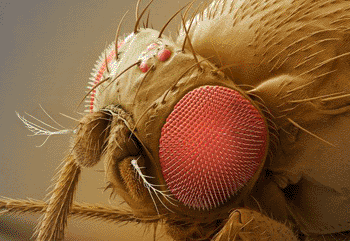Study of Fruit Fly Genes Unlocks Secrets Hidden in Massive Human Gene Analogues
By LabMedica International staff writers
Posted on 02 Jul 2012
The value of the lowly fruit fly (Drosophila melanogaster) to modern genomic research has been demonstrated once again in a study that used a simplified fly gene to explain the function of two mammalian genes that are too large to be studied by conventional techniques.Posted on 02 Jul 2012
The two mammalian genes are the histone lysine methyltransferases MLL2 and MLL3. Each of these genes contains more than 15,000 base pairs - more than 10 times the number found in a typical gene. These genes are of interest because recent research has found that several types of cancer included non-Hodgkin lymphoma, colorectal cancer, kidney cancer, bladder cancer, medulloblastoma, breast cancer, and prostate cancer are linked to MLL2 and MLL3 mutations.

Image: Colored scanning electron micrograph (SEM) of the head of a male fruit fly (Drosophila melanogaster) (Photo courtesy of Power and Syred).
Phylogenetic analyses revealed that the ancestor of these genes underwent a fission event in the distant past and that in the fruit fly each of these genes became two smaller genes. In a study published in the June 1, 2012, issue of the journal Development investigators at Loyola University (Chicago, IL, USA) presented results of genomic analysis of the fly genes TRR and CMI, which are the smaller analogues of MLL2 and MLL3.
“Evolution has given us a gift,” said senior author Dr. Andrew K. Dingwall, associate professor of pathology at Loyola University. “These fruit fly genes give us unique insight into the massive human MLL2 and MLL3 genes that are almost impossible to study because they are so large.”
Research will continue in order to discover the function of the fruit fly genes by inducing various mutations into them and then observing the effects on the flies. Ultimately, this type of study will lead to better understanding of the effects of mutations in the MLL2 and MLL3 genes, which trigger the uncontrolled reproduction of cancer cells in humans.
Related Links:
Loyola University













